4 Ways to Make Pesto Sauce
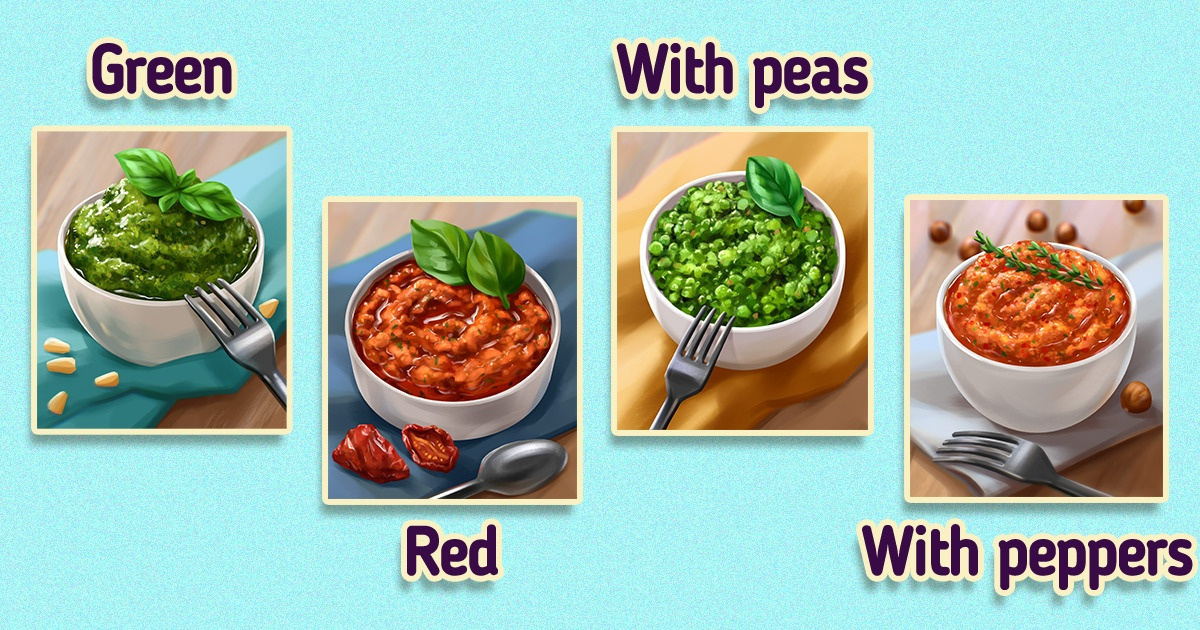
Classic pesto sauce is made from fresh basil, garlic, olive oil, pine nuts, and cheese, ground into a paste. Pesto is Italian for pounded. The thing is, in Italy, for centuries this sauce had been made with mortar and pestle. Today, home-made pesto is often made with a blender or a food processor.
5-Minute Crafts has found 4 pesto sauce recipes of famous chefs. If you read them, you can cook plain pasta, mix it with this sauce, and surprise your friends and family.
1. Green pesto
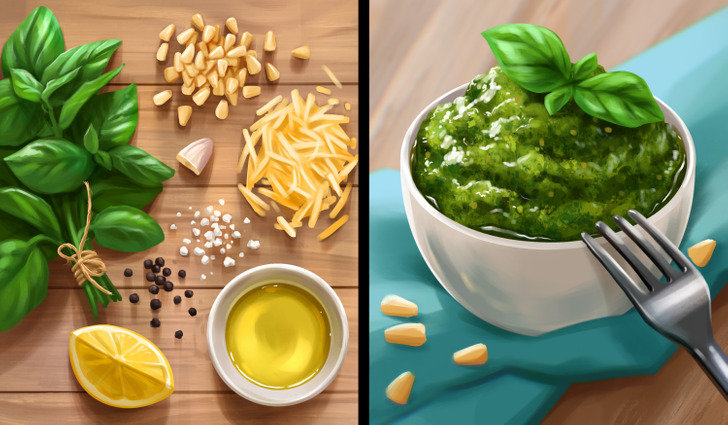
We took this classic pesto genovese recipe from Jamie Oliver. The chef describes the traditional method as something you should use a mortar and a pestle, but you can also mix the ingredients in a blender.
You need:
- 1/2 clove garlic
- big bunch of fresh basil
- handful of pine nuts
- handful of grated Parmesan cheese
- extra virgin olive oil
- salt and pepper
- lemon (optional)
How to make:
- Take a mortar and pestle and pound the garlic with a pinch of sea salt.
- Cut the basil and grind them into a paste.
- Add pine nuts. You can fry them a little on the pan to make the sauce creamy.
- Pound the nuts and add some of the grated Parmesan cheese.
- Sprinkle the mix with a bit of olive oil to connect the ingredients and create viscosity.
- Add more cheese, salt, and black pepper.
- Taste the sauce. If needed, add more grated cheese or olive oil until you are satisfied with the taste and texture.
- You can add some lemon juice to make the sauce a bit sour, but it’s optional.
2. Red pesto
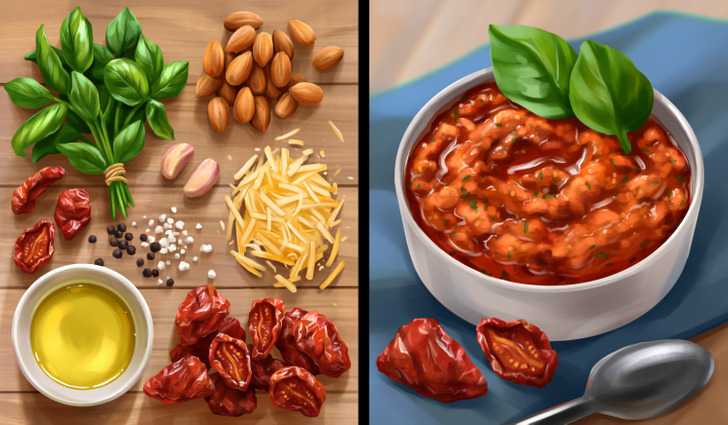
Another popular kind of sauce is pesto rosso from Sicily. Its recipe is a bit like the previous one but instead of pine nuts, almond are used, and tomatoes make the sauce red.
This recipe was taken from Gordon Ramsay. He suggests mixing the ingredients in a blender.
You need:
- 2 garlic cloves
- 30 grams fresh basil
- 50 grams almonds
- 60 grams grated Parmesan cheese
- 100 grams sun-dried tomatoes
- 100 grams olive oil
How to make:
- Prepare all the ingredients and put them into a blender.
- Mix the ingredients until you have a homogenous mix.
3. Pesto with peas
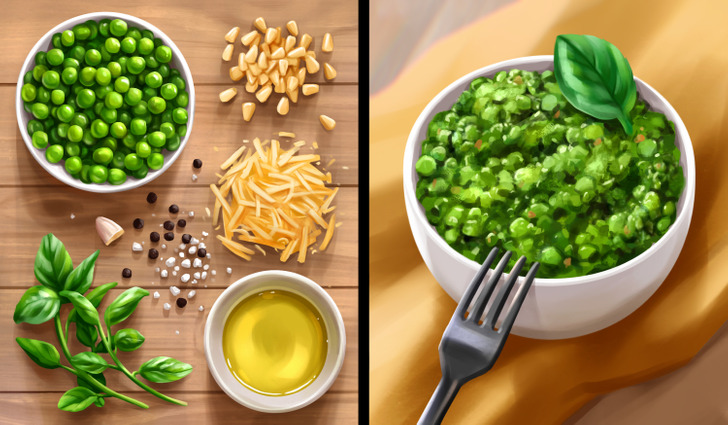
Jamie Oliver suggests an experiment where instead of a lot of basil, you need green peas. This is a good option if you want to make it fresher and with more of a herbal taste pesto or if you a limited in the ingredients for the traditional recipe.
If the latter is true, Jamie suggests swapping pine nuts with almonds. You don’t have to have classic Parmesan — you can just add any firm cheese you have in your kitchen.
Just like in the first recipe, Jamie uses a mortar and a pestle to make the sauce but you are free to use a blender.
You need:
- 100 grams frozen peas
- 1/4 garlic clove
- 30 grams of pine nuts or any other nuts
- 2 sprigs of fresh basil or mint
- 30 grams of Parmesan cheese or any other firm cheese
- 2 tbsp extra virgin olive oil
- salt and black pepper
How to make:
- Put a strainer into a pot of boiling water or even into the pot with the pasta while it’s being cooked. Add the peas into the strainer and blanch them for 2 minutes.
- Take the pestle and the mortar and grind the garlic with a pinch of sea salt. Add nuts and basil.
- Remove the water from the peas and add them to the mix. Pound them to the texture you like: fine, medium, or chunky.
- Add the cheese and around 2 tbsp of extra virgin oil. Mix the ingredients, add salt and black pepper.
4. Pesto with fried peppers
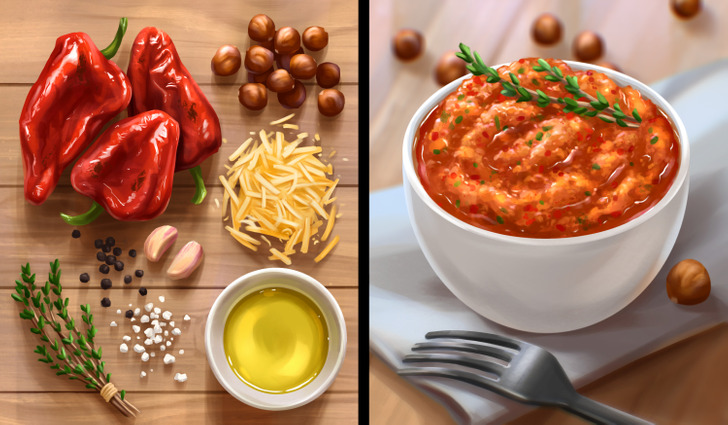
Another Jamie Oliver’s experiment is red pesto where instead of sun-dried tomatoes, you use fried peppers, and fresh thyme instead of basil. He replaced pine nuts with hazelnut, and instead of Parmesan, he uses another famous goat-milk based cheese — pecorino. But you can replace pecorino with any goat cheese you have.
You need:
- 2 garlic cloves
- 1/2 bunches or fresh thyme
- 450 grams of fried red peppers
- handful of hazelnut
- handful of grated pecorino cheese
- extra virgin olive oil
- salt and pepper
How to make:
- Fry the thyme and hazelnuts until they’re golden.
- Pound the thyme and hazelnuts with cut peppers and garlic.
- Add sea salt and black pepper.
- Add grated cheese and enough olive oil. Mix the ingredients in any way you want until you have the texture you like.